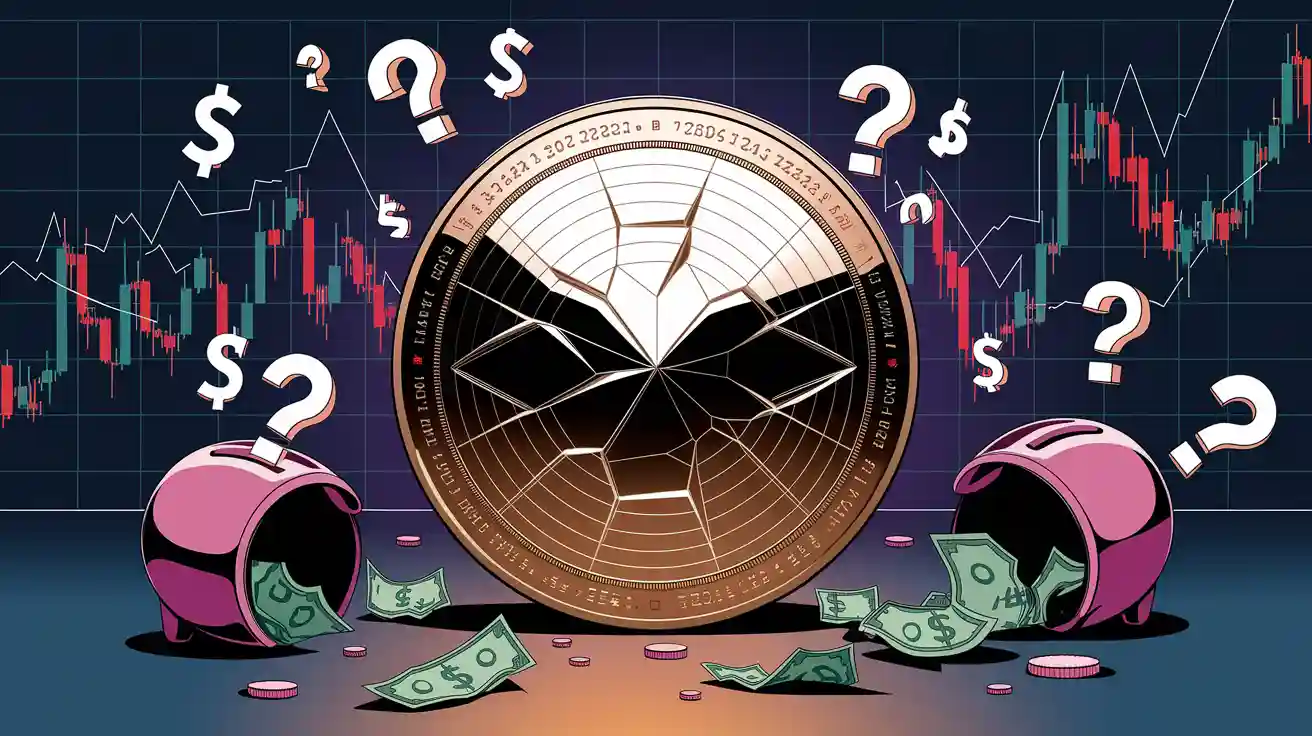What is a Shitcoin in Cryptocurrency?
2025-04-30 08:46:24
A common question among cryptocurrency enthusiasts is, "What is shitcoin?" A shitcoin refers to a cryptocurrency that holds little to no utility or intrinsic value. These coins frequently enter the market without a defined purpose, acting more as speculative tools than functional assets. Their emergence has significantly influenced cryptocurrency investment trends, fostering speculative behavior akin to gambling. This dynamic has resulted in both substantial profits and severe losses for investors. Understanding what is shitcoin and distinguishing it from other cryptocurrencies is crucial for investors to avoid scams and make well-informed decisions. Unlike bitcoin, which boasts a clear use case and solid fundamentals, shitcoins often lack transparency, making them highly risky investments.
Characteristics of a Shitcoin

Lack of Utility or Purpose
A defining trait of a shitcoin is its lack of real use case or practical application. Unlike bitcoin, which serves as a decentralized digital currency, many shitcoins fail to address any specific problem or provide meaningful solutions. These cryptocurrencies often exist solely for speculative purposes, with no infrastructure or ecosystem to support their growth. For instance, famous examples of shitcoins like Dogecoin highlight this issue. While Dogecoin gained popularity as a memecoin, it lacks robust market infrastructure, minimal developer activity, and widespread user adoption.
Independent studies have identified several utility deficits in tokens classified as shitcoins:
- Lack of infrastructure: Many shitcoins, including Dogecoin, lack essential components like custodians and brokers.
- Unsophisticated community: Retail investors dominate the user base, often lacking the expertise of early adopters.
- Minimal development: Developer activity remains stagnant, contrasting with the thriving ecosystems of established cryptocurrencies.
- Inflated supply: Cryptocurrencies like Dogecoin have no supply cap, leading to high inflation rates.
- Ownership concentration: A small number of holders control a significant portion of these assets, creating inequality.
The lack of real use case makes these cryptocurrencies highly speculative and prone to pump-and-dump schemes. Investors should remain cautious when evaluating projects that fail to demonstrate clear utility or purpose.
Poor Development and Weak Fundamentals
Shitcoins often suffer from poor development and weak fundamentals, making them unreliable investments. Many of these projects lack innovative technology, well-written code, or a credible development team. Anonymous creators and unrealistic promises further erode trust in these cryptocurrencies.
A statistical analysis of shitcoins reveals alarming trends:
| Indicator | Description |
|---|---|
| Extreme price volatility | Suggests speculative activities and pump-and-dump schemes. |
| Lack of real use cases | Indicates no practical application, leading to instability. |
| Poor code and technology | Reflects weak infrastructure and lack of innovation. |
| Anonymous development teams | Raises concerns about credibility and project intentions. |
| Unrealistic promises and false advertising | Creates false expectations to attract investors. |
| Lack of public acceptance | Results in low demand and value, as businesses rarely adopt these cryptocurrencies. |
| No clear purpose or roadmap | Suggests hype-driven projects with no solid foundation. |
The rise of shitcoins has led to a surge in poorly developed projects that prioritize short-term gains over long-term sustainability. Investors should scrutinize the fundamentals of any cryptocurrency before committing funds.
Overhyped Marketing and Speculation
Overhyped marketing is another hallmark of a shitcoin. Developers often rely on inflated hype and aggressive promotional campaigns to attract investors. Social media platforms play a significant role in amplifying this phenomenon. A single tweet from an influential figure can cause dramatic price swings, fueling speculative behavior.
Market speculation indices and sentiment analysis highlight the impact of overhyped marketing:
- Sentiment analysis evaluates the tone of social media posts to gauge public opinion.
- Positive news often triggers price surges, while negative rumors lead to rapid declines.
- The cryptocurrency market remains highly sensitive to public sentiment, making it vulnerable to manipulation.
Famous examples of shitcoins like Dogecoin illustrate how memecoins are shitcoins that thrive on hype rather than substance. While it is easy to create a shitcoin and generate buzz, these projects often lack the fundamentals needed for long-term success. Investors should remain wary of projects that rely heavily on marketing without delivering tangible value.
Risks and Dangers of Investing in Shitcoins
Extreme Volatility and Loss of Value
Shitcoins are notorious for their severe price volatility, making them high-risk investments. Unlike established cryptocurrencies like bitcoin, which have market trust and stability, shitcoins often experience drastic price swings. These fluctuations stem from speculative trading and pump-and-dump schemes, where prices are artificially inflated before crashing.
A comparison of shitcoins and established cryptocurrencies highlights their instability:
| Characteristic/Risk | Shitcoins | Established Cryptocurrencies |
|---|---|---|
| Extreme price volatility | Highly speculative and prone to drastic price changes | Generally more stable due to market acceptance |
| Pump and dump schemes | Frequently associated with manipulative schemes | Less prone to such schemes due to market trust |
Investors often face significant losses when the hype surrounding a memecoin or other shitcoin fades. The rise of shitcoins has amplified these risks, leaving many investors vulnerable to financial ruin.
High Risk of Scams and Fraud
The cryptocurrency market has seen a surge in scams, with shitcoins being a common target for fraudsters. These scams include pump-and-dump schemes, fake investment platforms, and phishing attacks. Fraudsters exploit the lack of transparency and regulation in the market to deceive investors.
Reports indicate alarming statistics:
| Type of Scam | Losses (in billions) | Complaints Filed | Target Group |
|---|---|---|---|
| Total Crypto Scams | 9.3 | 859,000 | General |
| Investment Scams (Pig Butchering) | 5.8 | N/A | General |
| Elderly Victims | 2.8 | 33,369 | Aged 60 and over |
Financial regulatory agencies, such as the US Department of Justice, have taken steps to combat fraud. Recent efforts include seizing over $112 million linked to crypto scams and targeting schemes like "pig butchering," where victims are lured into fake investments. Despite these measures, the high risk of fraud persists, especially for inexperienced investors.
Lack of Regulation and Investor Protections
Shitcoins operate in a largely unregulated space, exposing investors to significant risks. Unlike traditional finance, where custodians and insurance protect assets, cryptocurrency markets often lack these safeguards.
| Protection Area | Traditional Finance | Cryptocurrency Markets (Often Lacking) |
|---|---|---|
| Custody of Assets | Regulated custodians hold assets, ensuring security and accountability. | Crypto platforms often serve as custodians, with varying security protocols, making asset recovery difficult if a platform fails. |
| Bankruptcy Protection | Clear legal frameworks protect investors’ assets during bankruptcies. | The evolving legal landscape around crypto bankruptcies leaves investors vulnerable and uncertain about recovering funds. |
| Insurance Coverage | Traditional accounts are often insured by organizations like SIPC. | Insurance for crypto holdings is not standard and often limited, with many platforms lacking comparable coverage. |
The lack of regulation makes shitcoins high-risk investments, as investors have limited recourse in cases of fraud or platform failure. This regulatory gap underscores the importance of cautious investing and thorough research before entering the cryptocurrency market.
Ways to Identify Shitcoins

Red Flags in Whitepapers and Roadmaps
Whitepapers and roadmaps serve as the foundation for any cryptocurrency project. They outline the vision, technology, and development plan, helping investors assess the project's credibility. However, certain red flags in these documents can indicate a potential shitcoin.
- Lack of technical depth: A legitimate cryptocurrency project should provide detailed explanations of its underlying technology. Whitepapers that fail to include technical specifics often lack substance and may signal an attempt to mislead investors.
- Vague or generic language: Buzzwords and jargon without clear explanations are common in whitepapers for shitcoins. Projects that rely on generic language instead of concrete details often aim to create hype rather than deliver value.
- Lack of transparency: Credible projects disclose information about their team members and partnerships. Whitepapers that omit these details raise concerns about the project's legitimacy.
Investors should conduct thorough research when analyzing whitepapers and roadmaps. A lack of clarity or depth in these documents often correlates with pump-and-dump schemes and extreme price volatility.
Tip: Always compare the whitepaper of a new cryptocurrency with established projects like bitcoin. This helps identify gaps in technical depth and transparency.
Unrealistic Promises and Hype
Unrealistic promises are a hallmark of shitcoins. Developers often make exaggerated claims to attract investors, promising high returns or revolutionary technology without evidence to back their assertions. These promises are typically paired with aggressive marketing campaigns that rely on social media influencers and viral content.
For example, many memecoins thrive on hype rather than substance. While they may experience a temporary price surge due to speculative trading, their lack of fundamentals often leads to rapid declines. This pattern is common in pump-and-dump schemes, where developers inflate the price before selling off their holdings, leaving other investors with significant losses.
Projects that promise guaranteed profits or claim to solve complex problems without providing technical details should be approached with caution. Investors must evaluate whether the promises align with the project's capabilities and roadmap.
Note: The rise of shitcoins has shown that hype-driven projects often prioritize short-term gains over long-term sustainability. Avoid investing in projects that rely solely on marketing to build their reputation.
Lack of Transparency and Credible Team Members
Transparency is a critical factor in assessing the credibility of a cryptocurrency project. Legitimate projects provide detailed information about their developers, leadership, and partnerships. Shitcoins, on the other hand, often lack transparency, with developers using fake identities or withholding information about key contributors.
Several cases highlight the impact of missing team credentials on token credibility:
- Lightchain.ai failed to disclose detailed information about its team, raising concerns among investors. Legitimate projects typically provide verifiable profiles of their developers and leadership.
- Developers frequently use unverified identities, making it difficult for investors to trust the project's intentions.
- The absence of information about founders is a common issue that undermines the credibility of many shitcoins.
Investors should prioritize projects with transparent teams and verifiable backgrounds. A lack of transparency often correlates with pump-and-dump schemes and other fraudulent activities. Conducting thorough research on the team behind a project can help avoid financial losses.
Alert: If a project does not provide clear information about its team, consider it a red flag. Transparency builds trust and is essential for long-term success in the cryptocurrency market.
Understanding what is shitcoin is essential for navigating the cryptocurrency market. Shitcoins often lack utility, transparency, and stability, exposing investors to significant risks such as price volatility, scams, and financial losses.
| Characteristic/Risk | Description |
|---|---|
| Lack of utility | Shitcoins rarely serve practical purposes or solve real-world problems. |
| Pump and dump schemes | Price is artificially inflated through coordinated buying, then dumped by creators. |
| Loss of investment | Significant financial losses due to lack of value and volatility. |
To avoid these pitfalls, investors should:
- Diversify token holdings to reduce risk.
- Monitor on-chain data for unusual patterns.
- Conduct thorough research on whitepapers, teams, and roadmaps.
By staying informed and cautious, investors can minimize risks and make smarter decisions in the evolving cryptocurrency landscape.
FAQ
What is the main difference between a shitcoin and a legitimate cryptocurrency?
A legitimate cryptocurrency offers utility and solves real-world problems. Shitcoins lack purpose, relying on hype and speculation for value.
How can investors protect themselves from shitcoin scams?
Investors should research whitepapers, verify team credentials, and avoid projects with unrealistic promises or vague roadmaps.
Are all memecoins considered shitcoins?
Not all memecoins are shitcoins. Some gain value through community support and adoption, but many lack fundamentals and remain speculative investments.